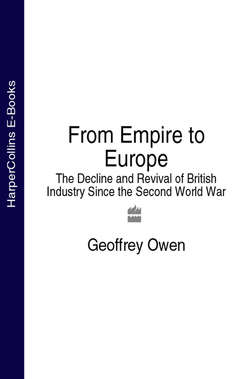Читать книгу From Empire to Europe: The Decline and Revival of British Industry Since the Second World War - Geoffrey Owen - Страница 24
The 1970s: The Grand Design Unravels
ОглавлениеThe 1960s were a decade in which managers, politicians and financiers had an exaggerated belief in mergers as a means of improving industrial performance. A few industries benefited from greater concentration, notably the electrical industry which is discussed in Chapter 8, but most of the others did not, the extreme case being the failure of British Leyland Motor Corporation (Chapter 9). Kearton’s grand design, applauded by the government and praised by most outside commentators, was flawed in two major respects.
First, it was based on a misreading of the market. The expectation was that a modernised industry, producing long runs of yarns and fabrics, would compete profitably against low-cost imports and become a major exporter to other European countries. But the commodity products which were the main focus of Courtaulds’ investment programme continued to be subject to fierce price competition, and the shift to a capital-intensive mode of production could not prevent a further loss of market share to imports from developing countries, even with the higher levels of protection which came into force in 1972. Moreover, the European market was very different from that of the US, being less homogeneous and more geared towards design and quality. Instead of a growing demand for standard, mass-produced fabrics, European consumers wanted more differentiated, more colourful and more stylish fabrics. This called for flexibility on the part of textile manufacturers and quick response to changing fashions. The structure which Kearton had put in place was not well suited for these conditions.
The second mistake was to under-estimate the disadvantages of vertical integration. The use of textile and garment companies as captive outlets for fibres was to tackle the problem from the wrong end: the fibre supplier, not the customer, called the tune. It was a technocratic approach which perhaps suited Kearton’s background and experience, but the management skills required for the mass production of fibres were different from those needed in textiles and clothing. The synergies which were supposed to flow from putting the various stages in the production process under single ownership were largely illusory.
The cracks in the grand design first became evident during the recession which followed the first oil shock at the end of 1973. This coincided with Britain’s entry into the Common Market, and the home market came under attack from Continental fabric suppliers, which over the preceding decade had pursued a very different strategy from Courtaulds. Instead of scale and standardisation, they had put more emphasis on design and technical innovation. Imports from the Continent rose sharply in the second half of the 1970s, and the British textile industry, having neglected European markets in the 1950s and 1960s, was not well equipped to respond. With some exceptions at the top end of the market, British manufacturers lacked products suitable for European consumers, and had little experience of marketing and distribution on the Continent.
Kearton retired from the chairmanship of Courtaulds in 1975. His successor, Arthur Knight, brought more order into an organisation which had been built up in a highly personal way by his predecessor; a new divisional structure was introduced, with clearer lines of accountability. Knight also began to reverse the policy of vertical integration, giving managers of each business greater freedom to buy or sell in the best market, instead of being tied to in-house suppliers and customers. But the fundamental problem was an excess of spinning and weaving capacity, planned for a market which had not materialised. One of the large new weaving plants, at Skelmersdale, was closed down in 1977, and there were cutbacks in other parts of the business. By the time of Knight’s retirement in 1979, the errors made by Kearton had been partially corrected, but profits in the textile business remained poor, and Courtaulds was losing money on its two newest fibres, nylon and polyester. Contrary to the predictions of the 1969 Textile Council report, the creation of large textile groups had not halted Lancashire’s decline, nor had mergers brought much benefit to other parts of the industry. Courtaulds and Coats Patons had bought up several of the leading hosiery and knitwear manufacturers in the East Midlands, but the subsequent performance of these firms was worse than that of the ones which stayed independent. The largest and most profitable of the independents was Nottingham Manufacturing, owned and run by the Djanogly brothers, which was a major supplier of knitwear to Marks & Spencer. According to one account, ‘Courtaulds and Coats Patons were large, highly centralised companies with little experience or understanding of the hosiery and knitwear industries, and their problems occupied little time at board meetings.’45 Here, as in Lancashire, vertical integration had been a mistake.
